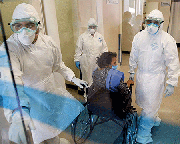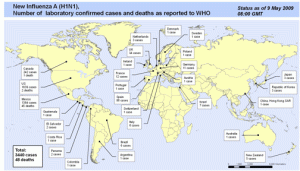
TAIPEI, Taiwan:- The swine flu virus — influenza A (H1N1) — has taught the world to “to expect a pandemic, and to plan for this event” even as the director-general of the World Health Organization (WHO) says, “No one can say how the current situation will evolve”.
WHO Director-General Dr. Margaret Chan, addressing by videoconference an ASEAN+3 health ministers’ special meeting on swine flu in Thailand on May 8, said the world was however “better prepared for an influenza pandemic than at any time in history”.
“This is a time of great uncertainty for all countries, and great pressure on ministers and ministries of health. The only certain thing that can be said about influenza viruses is that their behaviour is entirely unpredictable. No one can say how the current situation will evolve,” Dr. Chan said.
She further said that countries would, quite rightly, want to do everything possible to prevent the arrival of the virus or, once in a country, to delay its further spread and thereby flatten the epidemiological peak.
She however said that it was important for countries to “refrain from introducing economically and socially disruptive measures that lack solid scientific backing and bring no clear public health benefit.
“The rational use of travel- and trade-related measures is always wise. It is all the more wise at a time of severe economic downturn,” she said in the address posted on the WHO’s Website.
Don’t drop the ball on bird flu monitoring
She told health ministers not to “drop the ball on monitoring H5N1”, the bird flu virus, saying that the virus was endemic in poultry in parts of Asia.
“We have no idea how H5N1, [bird flu], will behave under the pressure of a pandemic,” she said.
She said the bird flu virus had “conditioned the public to equate an influenza pandemic with very severe disease and high mortality”.
Such a disease pattern was by no means inevitable during a pandemic, she said, adding, “On the contrary, it is exceptional.”
Dr. Chan said that ASEAN+3 countries knew from experience what it meant to be at centre-stage during the outbreak of a new disease.
“We must battle misperceptions with the facts, and respond to the disease with the facts,” she said.
Dr. Chan told the meeting that the decision to declare an influenza pandemic would fall on her shoulders and that she would take that decision “with utmost care and responsibility”.
She said that years of alert and expectation meant that most countries had preparedness plans, that vaccine manufacturing capacity had increased sharply, and that large stocks of antiviral drugs had been produced and procured.
She said that treatment courses from the WHO stockpile were being shipped to more than 70 countries in the developing world.
“We are, right now, gaining experience in the use of non-medical interventions, such as social distancing, to delay spread of the H1N1 virus,” she said.
Dr. Chan said that swine flu was the virus with the greatest pandemic potential and noted that it had sprung up in Mexico, a contrast to the bird flu which had broken out in Asia.
She said the WHO and its regional offices had tested their alert and response plans, also in operational exercises.
“We are prepared,” she said, adding that the WHO and its agencies have the support of the greatly strengthened International Health Regulations.
41 countries affected
The WHO Influenza A(H1N1) update 34, said that as of 06:00 GMT, on May 20 , 2009, 30 countries had officially reported 10, 243 cases of influenza A(H1N1) infection, including 80 deaths.

Mexico, the source of the outbreak, had reported 3648 laboratory confirmed human cases of infection, including 45 deaths.
The United States has reported 1639 laboratory confirmed human cases, including two deaths. Canada has reported 242 laboratory confirmed human cases, including one death, the WHO said.
The organization did not recommend travel restrictions related to the outbreak of the virus but said that individuals who were ill should delay travel plans and returning travelers who fell ill should seek appropriate medical care.
“These recommendations are prudent measures which can limit the spread of many communicable diseases, including influenza,” the update said.
A CNN report said that of the four major swine flu pandemics since 1889, a spring wave of relatively mild illness was followed by a second wave, a few months later, of a much more virulent disease.
This was the case in 1889, 1957, 1968 and in the catastrophic flu outbreak of 1918, which sickened an estimated third of the world’s population and killed, conservatively, 50 million people, the media agency reported.





